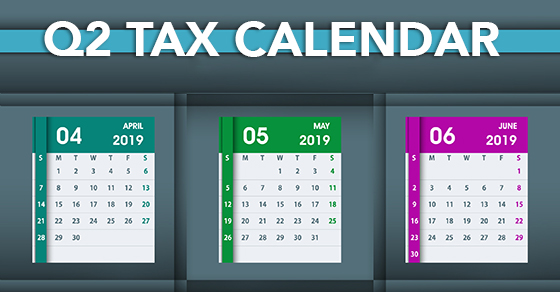Stay up to date! Subscribe to our future blog posts!
Acuity Blog
2019 Q2 tax calendar: Key deadlines for businesses and other employers
Here are some of the key tax-related deadlines that apply to businesses and other employers during the second quarter of 2019. Keep in mind that this list isn’t all-inclusive, so there may be additional deadlines that apply to you. Contact us to ensure you’re meeting all applicable deadlines and to learn more about the filing requirements.
April 1
- File with the IRS if you’re an employer that will electronically file 2018 Form 1097, Form 1098, Form 1099 (other than those with an earlier deadline) and/or Form W-2G.
- If your employees receive tips and you file electronically, file Form 8027.
- If you’re an Applicable Large Employer and filing electronically, file Forms 1094-C and 1095-C with the IRS. For all other providers of minimum essential coverage filing electronically, file Forms 1094-B and 1095-B with the IRS.
April 15
- If you’re a calendar-year corporation, file a 2018 income tax return (Form 1120) or file for an automatic six-month extension (Form 7004) and pay any tax due.
- Corporations pay the first installment of 2019 estimated income taxes.
April 30
- Employers report income tax withholding and FICA taxes for the first quarter of 2019 (Form 941) and pay any tax due.
May 10
- Employers report income tax withholding and FICA taxes for the first quarter of 2019 (Form 941), if you deposited on time and fully paid all of the associated taxes due.
June 17
- Corporations pay the second installment of 2019 estimated income taxes.
© 2019
Stay up to date! Subscribe to our future blog posts!
Lemonade Anyone?
4 Steps to Auditing AP
At most companies, the accounts payable (AP) department handles an enormous volume of transactions. So, the AP ledger may be prone to errors or used to bury fraudulent journal entries. How do auditors get a handle on AP? They use four key procedures to evaluate whether this account is free from “material misstatement” and compliant with U.S. Generally Accepted Accounting Principles (GAAP).
1. Examination of SOPs
Standard operating procedures (SOPs) are critical to a properly functioning AP department. However, some companies haven’t written formal SOPs — and others don’t always follow the SOPs they’ve created.
If SOPs exist, the audit team reviews them in detail. They also test a sample of transactions to determine whether payables personnel follow them.
If the AP department hasn’t created SOPs — or if existing SOPs don’t reflect what’s happening in the department — the audit team will temporarily stop fieldwork. Auditors will resume testing once the AP department has issued formal SOPs or updated them as needed.
2. Analysis of paper trails
Auditors use the term “vouching” to refer to the process of tracking a transaction from inception to completion. Analyzing this paper trail requires auditors to review original source documents, such as:
- Purchase orders,
- Vendor invoices,
- Journal entries for AP and inventory, and
- Bank records.
The audit team may select transactions randomly, as well as based on a transaction’s magnitude or frequency. They’ll also ascertain whether the company has complied with invoice terms and received the appropriate discounts.
3. Confirmations
Auditors may send forms to the company’s vendors asking them to “confirm” the balance owed. Confirmations can either:
- Include the amount due based on the company’s accounting records, or
- Leave the balance blank and ask the vendor to complete it.
If the amount confirmed by the vendor doesn’t match the amount recorded in the AP ledger, the audit team will note the exception and inquire about the reason. Unresolved discrepancies may require additional testing procedures and could even be cause for a qualified or adverse audit opinion, depending on the size and nature of the discrepancy.
4. Verification of financial statements
Auditors compare the amounts recorded in the company financial statements to the records maintained by the AP department. This includes reviewing the month-end close process to ensure that items are posted in the correct accounting period (the period in which expenses are incurred).
Auditors also review the process for identifying and recording related-party transactions. And they search for vendor invoices paid with cash and unrecorded liabilities involving goods or services received but yet not processed for payment.
Get it right
These four procedures may be conducted as part of a routine financial statement audit — or you may decide to hire an auditor to specifically target the AP department. Either way, your payables personnel can help streamline fieldwork by having the formal SOPs in place and source documents ready when the audit team arrives. Contact us for more information about what to expect during the coming audit season.
© 2018
Stay up to date! Subscribe to our future blog posts!
Tax reform expands availability of cash accounting
Under the Tax Cuts and Jobs Act (TCJA), many more businesses are now eligible to use the cash method of accounting for federal tax purposes. The cash method offers greater tax-planning flexibility, allowing some businesses to defer taxable income. Newly eligible businesses should determine whether the cash method would be advantageous and, if so, consider switching methods.
What’s changed?
Previously, the cash method was unavailable to certain businesses, including:
- C corporations — as well as partnerships (or limited liability companies taxed as partnerships) with C corporation partners — whose average annual gross receipts for the previous three tax years exceeded $5 million, and
- Businesses required to account for inventories, whose average annual gross receipts for the previous three tax years exceeded $1 million ($10 million for certain industries).
In addition, construction companies whose average annual gross receipts for the previous three tax years exceeded $10 million were required to use the percentage-of-completion method (PCM) to account for taxable income from long-term contracts (except for certain home construction contracts). Generally, the PCM method is less favorable, from a tax perspective, than the completed-contract method.
The TCJA raised all of these thresholds to $25 million, beginning with the 2018 tax year. In other words, if your business’s average gross receipts for the previous three tax years is $25 million or less, you generally now will be eligible for the cash method, regardless of how your business is structured, your industry or whether you have inventories. And construction firms under the threshold need not use PCM for jobs expected to be completed within two years.
You’re also eligible for streamlined inventory accounting rules. And you’re exempt from the complex uniform capitalization rules, which require certain expenses to be capitalized as inventory costs.
Should you switch?
If you’re eligible to switch to the cash method, you need to determine whether it’s the right method for you. Usually, if a business’s receivables exceed its payables, the cash method will allow more income to be deferred than will the accrual method. (Note, however, that the TCJA has a provision that limits the cash method’s advantages for businesses that prepare audited financial statements or file their financial statements with certain government entities.) It’s also important to consider the costs of switching, which may include maintaining two sets of books.
The IRS has established procedures for obtaining automatic consent to such a change, beginning with the 2018 tax year, by filing Form 3115 with your tax return. Contact us to learn more.
© 2018
Stay up to date! Subscribe to our future blog posts!





